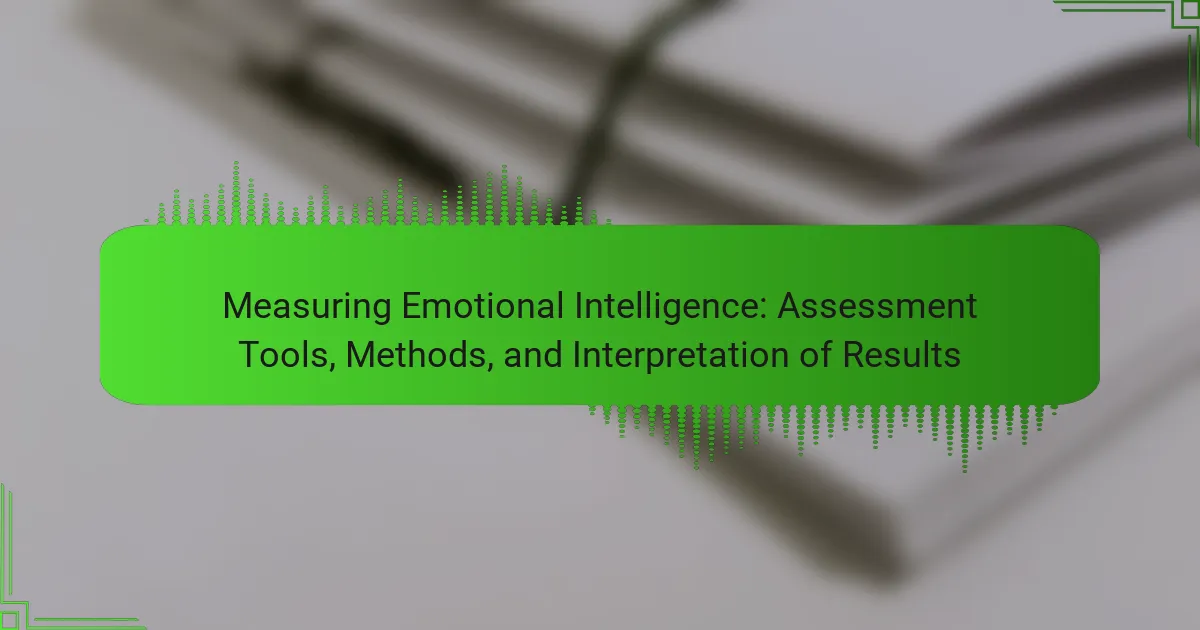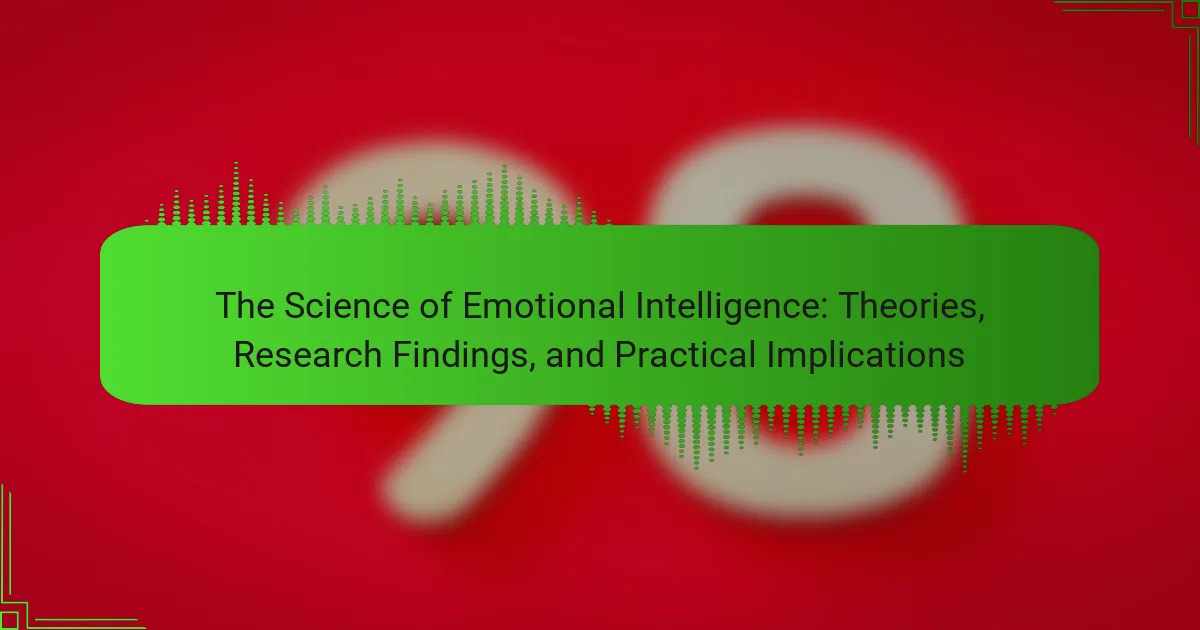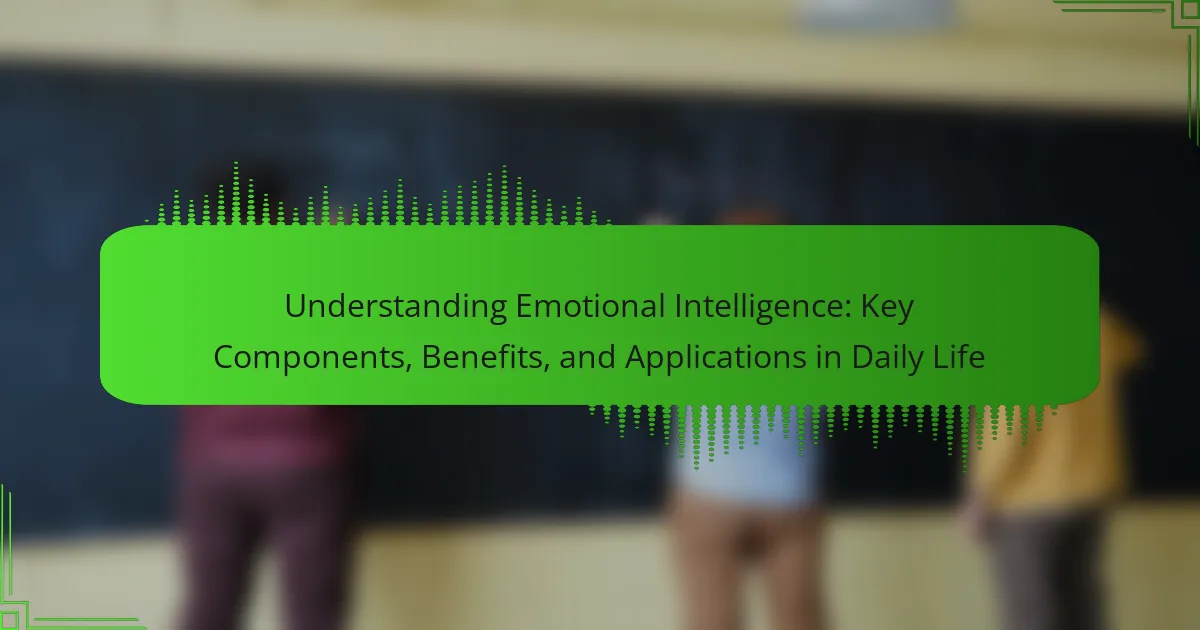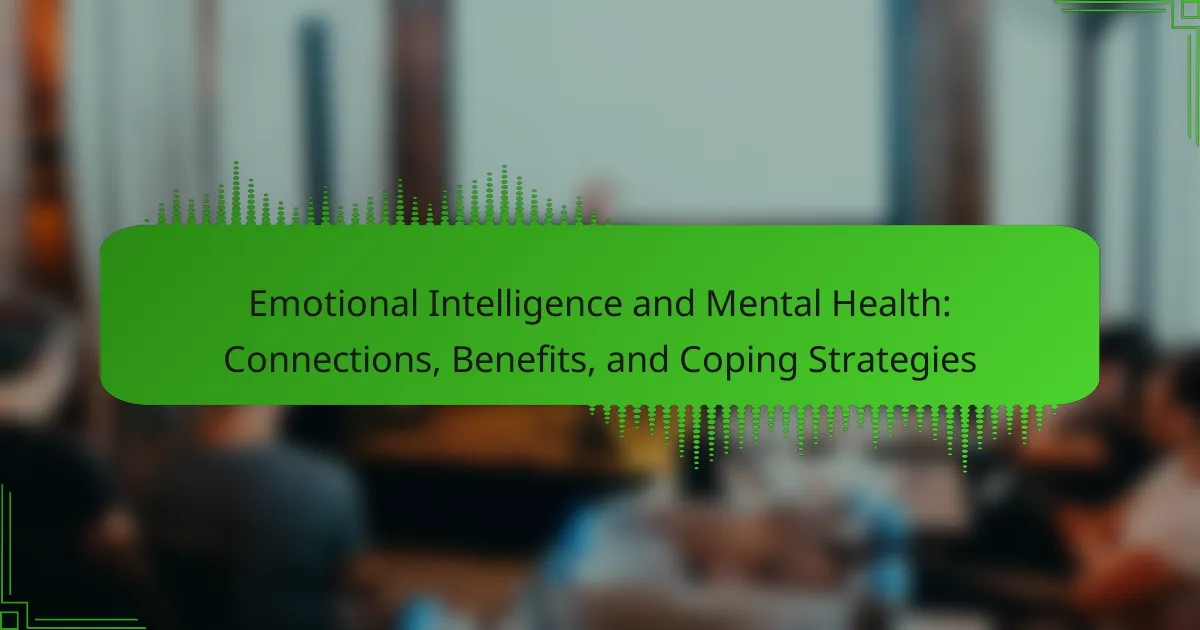Emotional intelligence (EI) refers to the ability to recognize, understand, and manage one’s own emotions while also influencing the emotions of others. This article examines the significance of emotional intelligence in personal and professional contexts, highlighting its correlation with improved communication, relationships, and job performance. It discusses various assessment tools and methods used to measure emotional intelligence, including self-awareness, self-regulation, motivation, empathy, and social skills. The interpretation of assessment results is also explored, emphasizing the importance of using validated tools and considering contextual factors for accurate evaluations. Best practices for measuring emotional intelligence are presented, including the use of peer assessments and structured interviews to enhance understanding and accuracy.
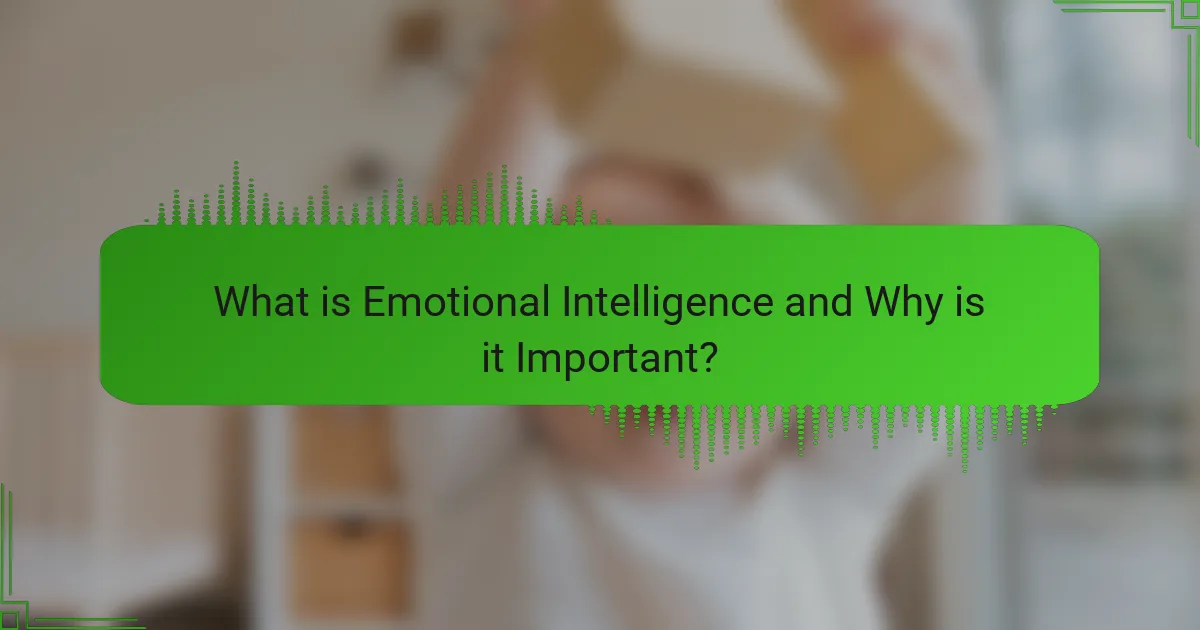
What is Emotional Intelligence and Why is it Important?
Emotional intelligence is the ability to recognize, understand, and manage our own emotions while recognizing, understanding, and influencing the emotions of others. It plays a crucial role in personal and professional success. High emotional intelligence leads to better communication, improved relationships, and effective conflict resolution. Research indicates that individuals with high emotional intelligence often outperform their peers in various settings. For instance, a study by TalentSmart found that emotional intelligence accounts for 58% of job performance across various industries. This underscores its importance in fostering teamwork and leadership.
How is Emotional Intelligence Defined?
Emotional intelligence is defined as the ability to recognize, understand, and manage our own emotions and the emotions of others. This concept encompasses skills such as emotional awareness, empathy, and emotional regulation. Research by Daniel Goleman highlights five key components: self-awareness, self-regulation, motivation, empathy, and social skills. Studies indicate that higher emotional intelligence can lead to improved interpersonal relationships and better decision-making. The ability to navigate social complexities is a critical aspect of emotional intelligence. Overall, it plays a significant role in personal and professional success.
What are the key components of Emotional Intelligence?
The key components of Emotional Intelligence are self-awareness, self-regulation, motivation, empathy, and social skills. Self-awareness involves recognizing one’s emotions and their effects. Self-regulation refers to managing emotions in healthy ways. Motivation is the drive to pursue goals with energy and persistence. Empathy is the ability to understand and share the feelings of others. Social skills encompass the ability to build relationships and navigate social networks effectively. Research by Daniel Goleman, a leading expert in the field, identifies these components as essential for effective emotional functioning and interpersonal relationships.
How does Emotional Intelligence impact personal and professional relationships?
Emotional intelligence significantly enhances personal and professional relationships. It allows individuals to understand and manage their own emotions effectively. This understanding fosters empathy towards others, improving communication and conflict resolution. High emotional intelligence leads to better teamwork and collaboration in professional settings. Studies indicate that emotionally intelligent leaders create more engaged and motivated teams. In personal relationships, emotional intelligence contributes to deeper connections and trust. It helps individuals navigate social complexities and build stronger bonds. Overall, emotional intelligence is a critical factor in fostering healthy and productive relationships.
What are the different types of Emotional Intelligence assessments?
There are several types of Emotional Intelligence assessments. These include self-report questionnaires, ability-based tests, and 360-degree feedback assessments. Self-report questionnaires, like the Emotional Quotient Inventory (EQ-i), rely on individuals to evaluate their own emotional skills. Ability-based tests, such as the Mayer-Salovey-Caruso Emotional Intelligence Test (MSCEIT), measure emotional intelligence through tasks that require emotional reasoning. 360-degree feedback assessments gather insights from multiple sources, including peers and supervisors, to provide a comprehensive view of an individual’s emotional intelligence. Each assessment type serves different purposes in evaluating emotional intelligence competencies.
How do self-report measures assess Emotional Intelligence?
Self-report measures assess Emotional Intelligence by asking individuals to evaluate their own emotional skills and awareness. These measures typically consist of questionnaires or surveys that include statements related to emotional perception, regulation, and expression. Respondents rate how accurately these statements reflect their feelings and behaviors. This method relies on the individual’s self-awareness and honesty in reporting their emotional experiences. Research indicates that self-report measures can provide valuable insights into a person’s emotional competencies. However, they may be influenced by social desirability bias, where respondents answer in a manner they believe is more acceptable. Despite this limitation, self-report measures remain a widely used tool in the assessment of Emotional Intelligence.
What role do ability-based assessments play in measuring Emotional Intelligence?
Ability-based assessments are crucial for measuring Emotional Intelligence (EI). They evaluate an individual’s capacity to perceive, use, understand, and manage emotions. These assessments focus on cognitive abilities related to emotional processing. They differ from self-report measures by providing objective data. Research indicates that ability-based assessments correlate with real-world outcomes, such as job performance. For instance, studies show that higher EI scores predict better workplace interactions. Overall, these assessments offer a reliable framework for understanding emotional competencies.
What methods are used to measure Emotional Intelligence?
Emotional Intelligence (EI) is measured using various methods. Common methods include self-report questionnaires, ability tests, and 360-degree feedback assessments. Self-report questionnaires, like the Emotional Quotient Inventory (EQ-i), ask individuals to rate their own emotional skills. Ability tests, such as the Mayer-Salovey-Caruso Emotional Intelligence Test (MSCEIT), evaluate an individual’s capacity to perceive, use, understand, and manage emotions. 360-degree feedback assessments gather insights from peers, subordinates, and supervisors to provide a comprehensive view of an individual’s emotional competencies. Research indicates that these methods are effective in assessing EI and can predict personal and professional outcomes.
How do qualitative methods contribute to Emotional Intelligence assessment?
Qualitative methods enhance Emotional Intelligence assessment by providing in-depth insights into emotional processes. These methods include interviews, focus groups, and open-ended surveys. They allow participants to express their feelings and experiences in their own words. This rich data reveals nuances that quantitative methods may overlook. Qualitative approaches help identify emotional patterns and behaviors. They also facilitate understanding of context and interpersonal dynamics. Research shows that qualitative insights can correlate with emotional awareness and regulation skills. Therefore, qualitative methods are vital for a comprehensive evaluation of Emotional Intelligence.
What are the advantages of quantitative methods in measuring Emotional Intelligence?
Quantitative methods in measuring Emotional Intelligence provide objective data for analysis. They facilitate statistical comparisons across different populations. These methods yield measurable results that can be replicated in various studies. Quantitative assessments often include standardized tests, ensuring reliability and validity. They enable researchers to identify trends and correlations effectively. For example, the Emotional Quotient Inventory (EQ-i) provides numerical scores for emotional competencies. This scoring system allows for clear benchmarking against normative data. Furthermore, quantitative methods can enhance the credibility of findings in academic and professional settings.
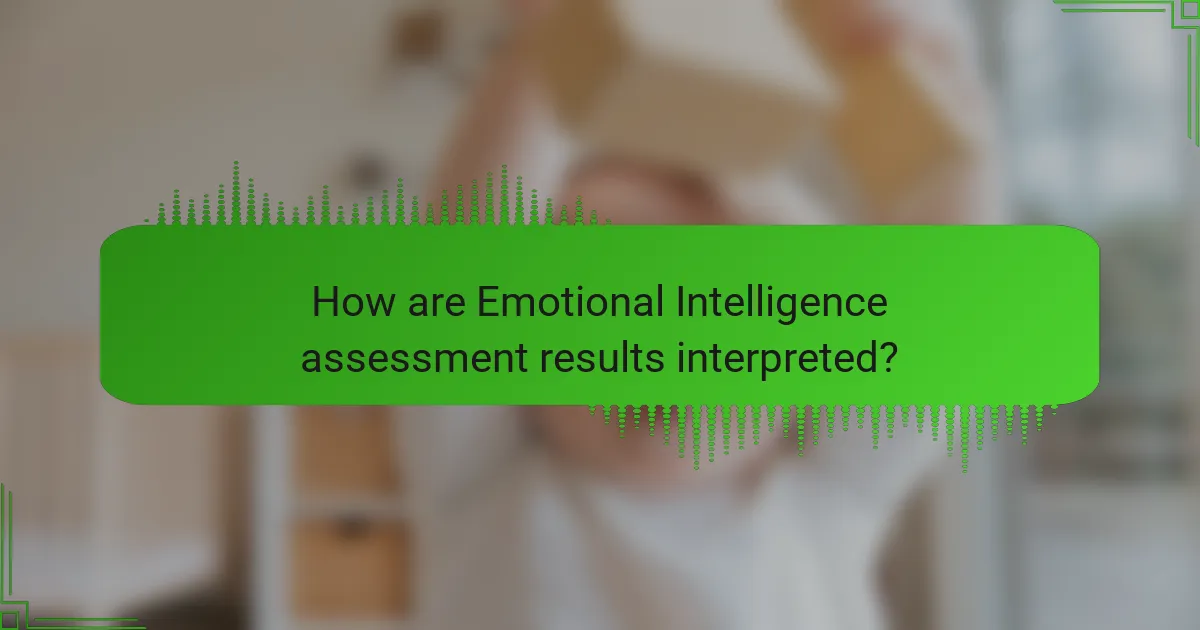
How are Emotional Intelligence assessment results interpreted?
Emotional Intelligence assessment results are interpreted by analyzing scores across various competencies. These competencies typically include self-awareness, self-regulation, motivation, empathy, and social skills. Each competency is scored to provide insights into an individual’s emotional strengths and weaknesses. Higher scores indicate stronger emotional intelligence abilities. The results are often compared to normative data to gauge relative performance. For instance, a score in the 75th percentile suggests better emotional intelligence than 75% of the population. Feedback sessions may accompany results to help individuals understand their scores. This interpretation aids in personal development and skill enhancement.
What do the scores from Emotional Intelligence assessments mean?
Scores from Emotional Intelligence assessments indicate an individual’s ability to recognize, understand, and manage emotions. Higher scores suggest greater emotional awareness and regulation skills. These assessments often measure several competencies, such as self-awareness, empathy, and interpersonal skills. For instance, a score of 120 may reflect strong emotional competencies, while a score of 80 could indicate areas for improvement. Research shows that individuals with higher emotional intelligence tend to have better relationships and job performance. Studies, such as those by Mayer, Salovey, and Caruso, demonstrate a correlation between emotional intelligence and success in various life domains.
How can one differentiate between high and low Emotional Intelligence scores?
High Emotional Intelligence (EI) scores indicate strong abilities in recognizing, understanding, and managing emotions. Low EI scores suggest difficulties in these areas. Individuals with high EI often exhibit empathy, effective communication, and conflict resolution skills. They can navigate social complexities with ease. In contrast, those with low EI may struggle with emotional regulation and relationship building. Research shows that high EI correlates with better mental health and job performance. Studies indicate that individuals with high EI score above 100 on standardized assessments, while those with low EI score below 70.
What factors influence the interpretation of Emotional Intelligence results?
The interpretation of Emotional Intelligence results is influenced by several factors. These factors include the assessment tool used, cultural context, and individual differences. Different tools may emphasize various aspects of Emotional Intelligence, leading to varied interpretations. Cultural context can shape emotional expression and perception, affecting results. Individual differences, such as personality traits and prior experiences, also play a significant role in how results are understood. Furthermore, the environment in which assessments are conducted can impact responses. Research indicates that these factors can lead to discrepancies in Emotional Intelligence evaluations across diverse populations.
What common misconceptions exist about Emotional Intelligence assessment results?
Common misconceptions about Emotional Intelligence (EI) assessment results include the belief that EI is fixed and unchangeable. Many people think that individuals cannot improve their emotional intelligence over time. In reality, research shows that emotional intelligence can be developed through training and practice. Another misconception is that EI assessments are purely subjective. However, many assessments utilize standardized measures to provide objective insights into emotional skills. Additionally, some believe that high EI guarantees success in all areas of life. Studies indicate that while EI contributes to success, other factors such as cognitive ability and personality also play significant roles. Lastly, it is often assumed that EI assessments are only relevant for personal relationships. In fact, EI is crucial in professional settings, influencing teamwork and leadership effectiveness.
How can biases affect the interpretation of Emotional Intelligence assessments?
Biases can significantly distort the interpretation of Emotional Intelligence assessments. They can lead to misjudgments about an individual’s emotional capabilities. For instance, cultural bias may favor certain emotional expressions over others. This can skew results in diverse populations. Confirmation bias may cause assessors to favor information that aligns with their preconceived notions. Consequently, this can impact the accuracy of the assessment outcomes. Research indicates that biases can affect both self-reported and observer-rated measures of emotional intelligence. Inaccurate interpretations can hinder personal development and workplace dynamics.
What should individuals avoid when interpreting their Emotional Intelligence scores?
Individuals should avoid overgeneralizing their Emotional Intelligence scores. Emotional Intelligence is a complex construct that cannot be fully captured by a single number. Relying solely on scores may lead to misinterpretations of one’s abilities. It is crucial to consider the context in which the assessment was conducted. Different tests may measure various aspects of Emotional Intelligence. Individuals should also avoid comparing their scores directly with others. Each person’s emotional landscape is unique, and scores can vary widely based on individual experiences. Lastly, individuals should not ignore feedback from others when interpreting their scores. External perspectives can provide valuable insights that scores alone may not reveal.
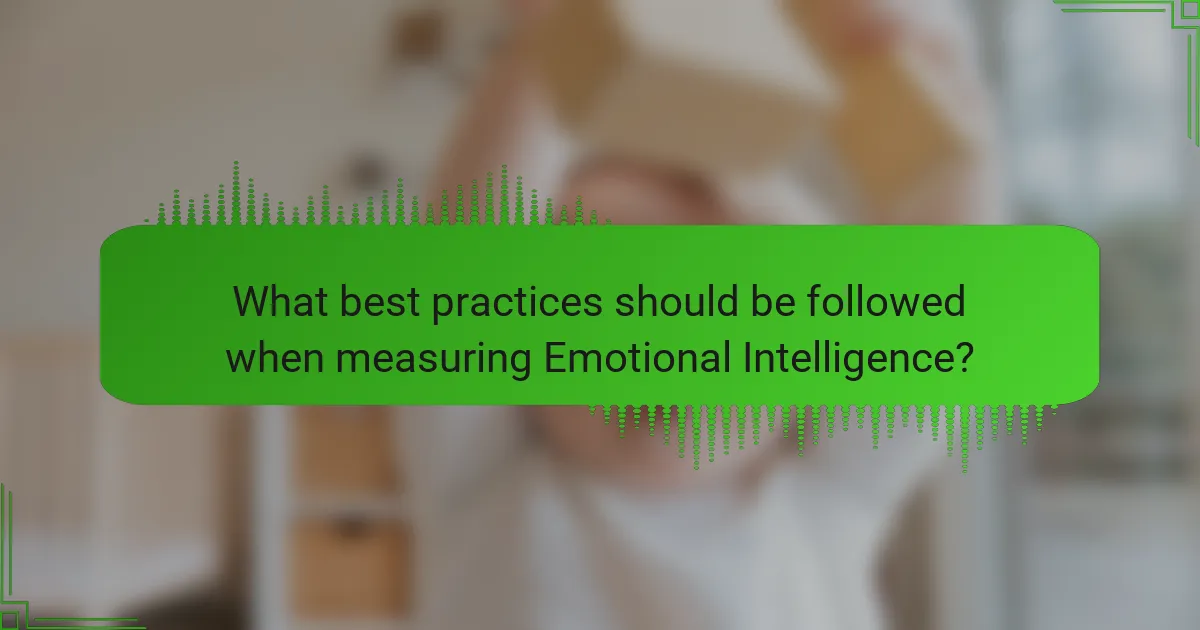
What best practices should be followed when measuring Emotional Intelligence?
Best practices for measuring Emotional Intelligence include using validated assessment tools. These tools should be reliable and scientifically backed. Self-report questionnaires are common but should be complemented by peer assessments. This approach provides a more comprehensive view. Additionally, contextual factors must be considered during evaluation. Emotional Intelligence can vary across different environments. Regularly reviewing and updating measurement methods is crucial. This ensures they remain relevant and effective. Training evaluators on the nuances of Emotional Intelligence can enhance accuracy. Research indicates that structured interviews can also yield valuable insights.
How can individuals prepare for an Emotional Intelligence assessment?
Individuals can prepare for an Emotional Intelligence assessment by understanding key concepts of emotional intelligence. Familiarizing themselves with the five components—self-awareness, self-regulation, motivation, empathy, and social skills—is essential. Practicing self-reflection helps individuals identify their emotional strengths and weaknesses. Engaging in mindfulness exercises can enhance self-awareness and emotional regulation. Additionally, seeking feedback from others can provide insight into interpersonal skills. Reviewing sample questions from emotional intelligence assessments can help in understanding the format. Finally, ensuring a calm mindset before the assessment can improve performance.
What strategies can enhance the accuracy of Emotional Intelligence assessments?
Utilizing multiple assessment methods can enhance the accuracy of Emotional Intelligence assessments. Combining self-report questionnaires with peer evaluations provides a more comprehensive view. Incorporating behavioral assessments allows for real-time observation of emotional responses. Training assessors on emotional intelligence concepts improves evaluation consistency. Regularly updating assessment tools ensures they remain relevant and valid. Research indicates that diverse methods lead to more reliable results. A study by Schutte et al. (2001) supports the use of multi-method approaches to assess emotional intelligence effectively.
What are some tips for effectively using Emotional Intelligence assessment results?
To effectively use Emotional Intelligence assessment results, first, analyze the specific scores and feedback provided. Understand your strengths and areas for improvement. Next, create a development plan that targets these areas. Set measurable goals to track progress over time. Regularly review and adjust your plan based on ongoing experiences and feedback. Engage in training or workshops to enhance skills identified in the assessment. Seek feedback from peers to gain additional perspectives on your emotional intelligence. Finally, apply learned skills in real-life situations to reinforce and solidify your emotional intelligence capabilities.
How can individuals leverage their Emotional Intelligence scores for personal growth?
Individuals can leverage their Emotional Intelligence (EI) scores for personal growth by identifying strengths and weaknesses. Understanding EI scores helps individuals recognize areas needing improvement. They can set specific goals based on their scores. For example, if a score indicates low empathy, individuals can focus on developing this skill. Practicing active listening can enhance emotional awareness. Engaging in feedback sessions can provide insights into emotional responses. Additionally, individuals can utilize EI assessments to track progress over time. Research shows that individuals with high emotional intelligence often experience better relationships and job performance. This correlation supports the value of using EI scores for targeted personal development.
What steps can organizations take to implement Emotional Intelligence findings for team development?
Organizations can implement Emotional Intelligence findings for team development by integrating training programs focused on emotional skills. These programs should include workshops on self-awareness, empathy, and interpersonal communication. Regular assessments can measure team members’ emotional intelligence levels. Feedback sessions can provide insights into individual and team emotional dynamics. Additionally, organizations should encourage open communication and create a supportive environment. Leadership should model emotionally intelligent behavior to reinforce its importance. Research shows that teams with high emotional intelligence perform better and have improved collaboration (Goleman, 1995).
Measuring Emotional Intelligence (EI) involves assessing the ability to recognize, understand, and manage emotions in oneself and others. This article explores various assessment tools and methods, including self-report questionnaires, ability-based tests, and qualitative approaches, highlighting their roles in evaluating emotional competencies. Key components of EI, such as self-awareness, empathy, and social skills, are discussed, along with the interpretation of assessment results and common misconceptions. Additionally, the article outlines best practices for measuring EI and offers strategies for personal and organizational development based on assessment findings.
